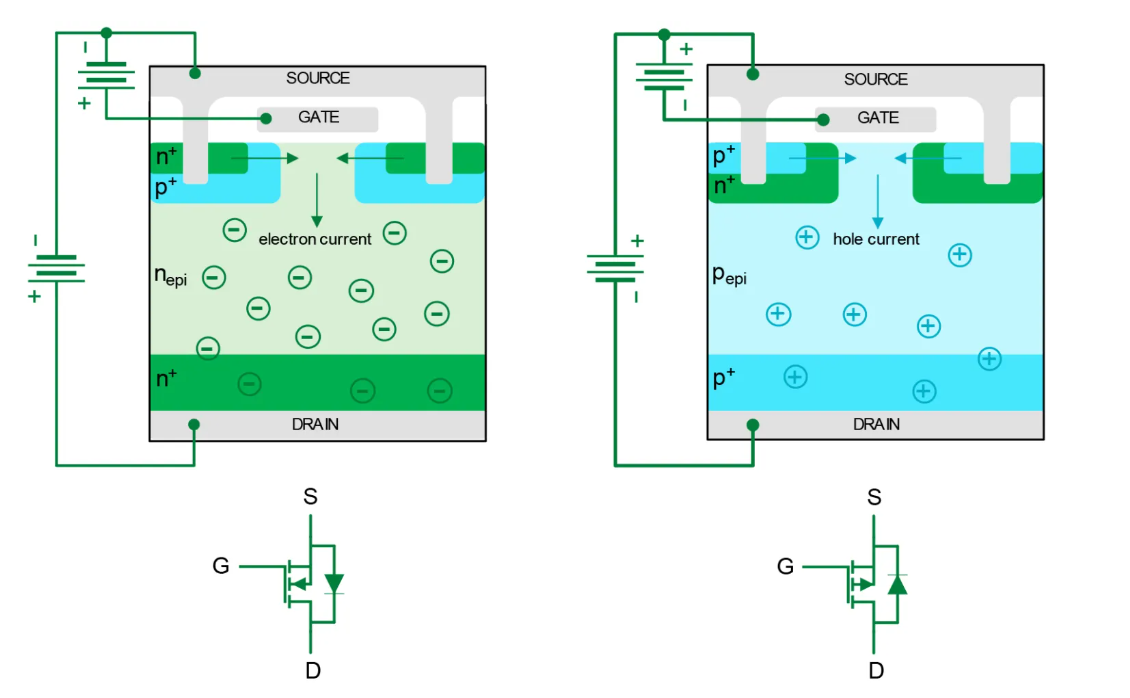MOSFET
P-channel and N-channel MOSFETs (Metal-Oxide-Semiconductor Field-Effect Transistors) are the two main types of MOSFETs used in electronic circuits, and they differ primarily in the type of charge carriers that flow through their channels, as well as in their behavior under different biasing conditions. Understanding the difference between these two types is crucial for designing efficient circuits, especially in digital and analog systems.
N-Channel MOSFET:
In an N-channel MOSFET, the current is carried by electrons, which are the majority charge carriers. The transistor has a n-type channel between the source and drain, and when a positive voltage is applied to the gate relative to the source, it creates an electric field that attracts electrons into the channel. This accumulation of electrons decreases the resistance between the source and drain, allowing current to flow. N-channel MOSFETs are typically used for switching and amplification applications because electrons, being more mobile than holes, provide higher conductivity and faster switching speeds.
An N-channel MOSFET is normally on (conducting) when a positive voltage is applied to the gate and is off (non-conducting) when the gate voltage is zero or negative relative to the source. This makes it very efficient for use in logic circuits, power supplies, and amplifiers. N-channel MOSFETs are also more commonly used than P-channel MOSFETs in digital systems due to their higher electron mobility, which leads to lower on-resistance and improved performance.
P-Channel MOSFET:
In contrast, a P-channel MOSFET has a p-type channel, and the current is carried by holes (the absence of electrons, behaving like positive charge carriers). For current to flow in a P-channel MOSFET, a negative voltage must be applied to the gate relative to the source. This negative voltage attracts holes into the channel, reducing the resistance between the source and the drain, allowing current to flow. P-channel MOSFETs are often used in complementary configurations with N-channel MOSFETs in circuits like push-pull amplifiers and CMOS logic circuits to provide efficient switching and low power consumption.
In a P-channel MOSFET, the device is on (conducting) when the gate voltage is sufficiently negative relative to the source and is off when the gate is at a voltage near or equal to the source. While P-channel MOSFETs are not as efficient as N-channel MOSFETs because holes are less mobile than electrons, they are essential for forming complementary pairs in logic circuits (such as CMOS) where both types of MOSFETs are used to create low-power and high-speed switching circuits.
N-Channel MOSFET:
In an N-channel MOSFET, the current is carried by electrons, which are the majority charge carriers. The transistor has a n-type channel between the source and drain, and when a positive voltage is applied to the gate relative to the source, it creates an electric field that attracts electrons into the channel. This accumulation of electrons decreases the resistance between the source and drain, allowing current to flow. N-channel MOSFETs are typically used for switching and amplification applications because electrons, being more mobile than holes, provide higher conductivity and faster switching speeds.
An N-channel MOSFET is normally on (conducting) when a positive voltage is applied to the gate and is off (non-conducting) when the gate voltage is zero or negative relative to the source. This makes it very efficient for use in logic circuits, power supplies, and amplifiers. N-channel MOSFETs are also more commonly used than P-channel MOSFETs in digital systems due to their higher electron mobility, which leads to lower on-resistance and improved performance.
P-Channel MOSFET:
In contrast, a P-channel MOSFET has a p-type channel, and the current is carried by holes (the absence of electrons, behaving like positive charge carriers). For current to flow in a P-channel MOSFET, a negative voltage must be applied to the gate relative to the source. This negative voltage attracts holes into the channel, reducing the resistance between the source and the drain, allowing current to flow. P-channel MOSFETs are often used in complementary configurations with N-channel MOSFETs in circuits like push-pull amplifiers and CMOS logic circuits to provide efficient switching and low power consumption.
In a P-channel MOSFET, the device is on (conducting) when the gate voltage is sufficiently negative relative to the source and is off when the gate is at a voltage near or equal to the source. While P-channel MOSFETs are not as efficient as N-channel MOSFETs because holes are less mobile than electrons, they are essential for forming complementary pairs in logic circuits (such as CMOS) where both types of MOSFETs are used to create low-power and high-speed switching circuits.
